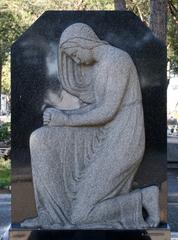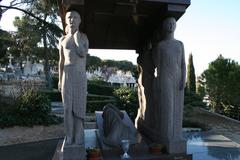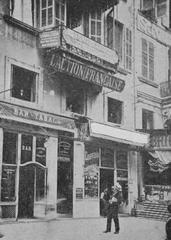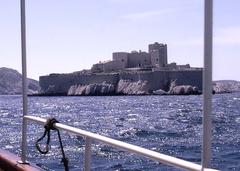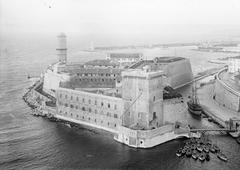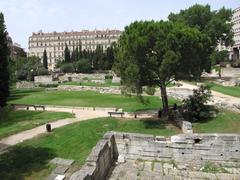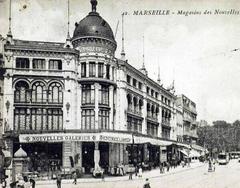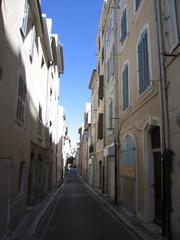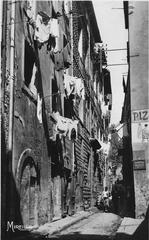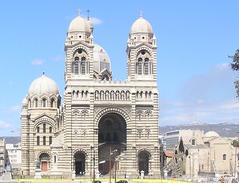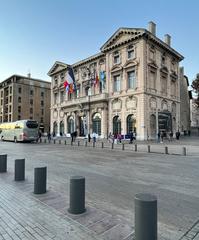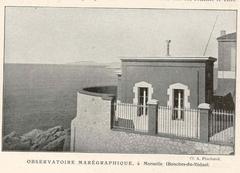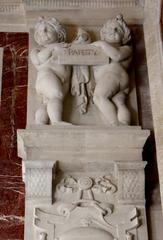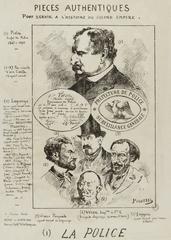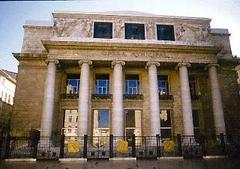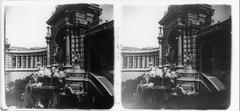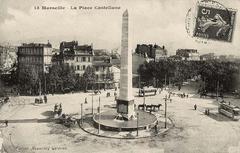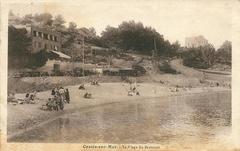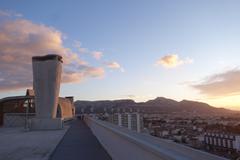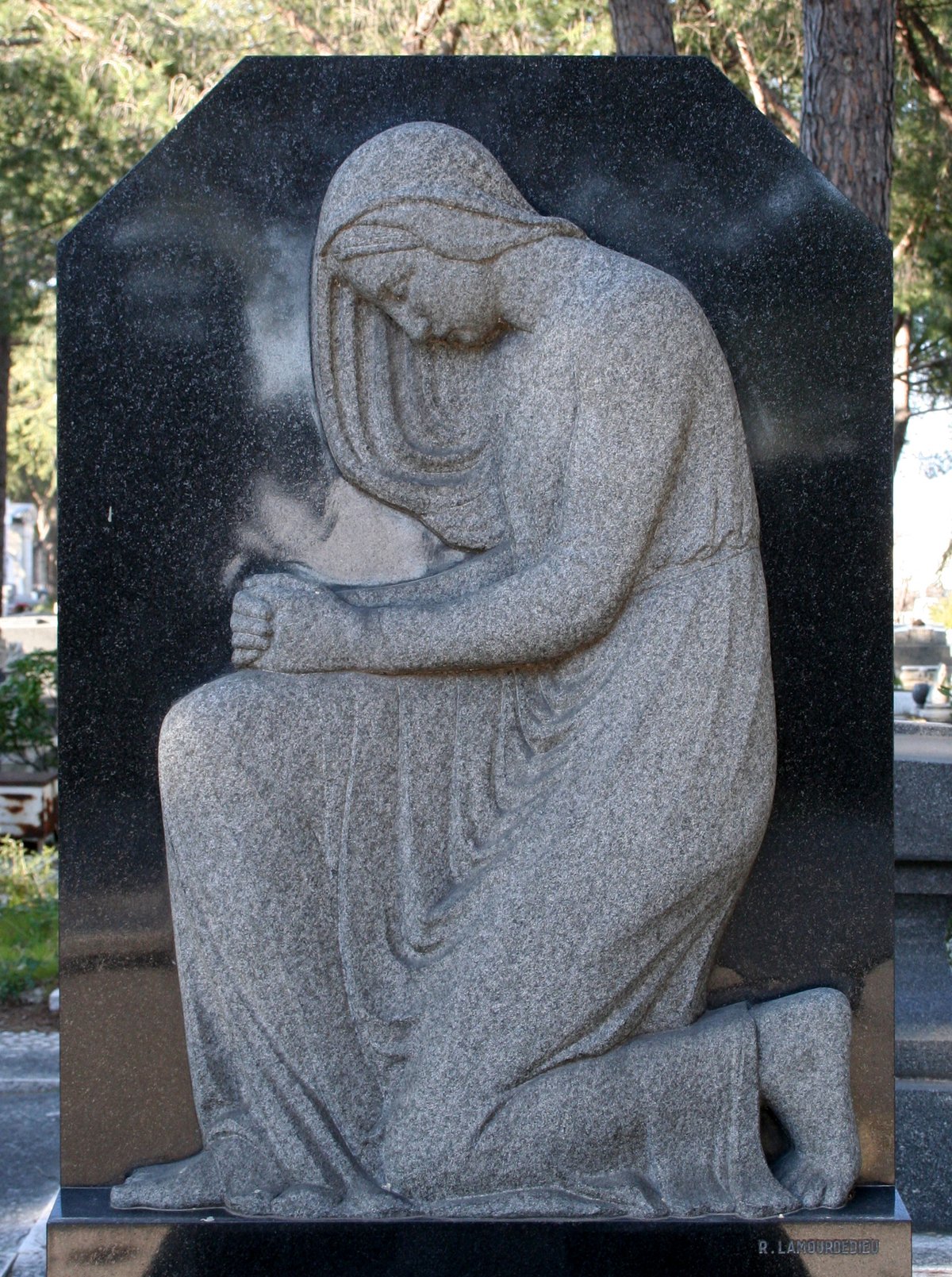
Saint Pierre Cemetery Marseille: Visiting Hours, Tickets, and Complete Travel Guide
Date: 15/06/2025
Introduction
Saint Pierre Cemetery (Cimetière Saint-Pierre) in Marseille is one of France’s largest and most culturally significant burial grounds. Spanning over 63 hectares in the city’s 5th and 10th arrondissements, this vast necropolis is not only a resting place for over 100,000 individuals but also a profound testament to Marseille’s layered history, architectural innovation, and multicultural heritage. Established in the mid-19th century to address the city’s growing population and the need for a centralized cemetery, Saint Pierre has evolved into a remarkable open-air museum of funerary art, religious diversity, and civic memory.
This comprehensive guide details the cemetery’s origins, notable monuments, practical visitor information (hours, tickets, accessibility), and highlights to help you make the most of your visit to this unique Marseille historical site. For official updates and deeper insights, consult resources from Marseille Tourism and the Marseille City Official Site.
Historical Background and Development
Origins and Establishment
Saint Pierre Cemetery was established in 1855, following Marseille’s rapid urban growth and the limitations of smaller, scattered burial sites. The city acquired land in the rural Saint-Pierre district to create a new necropolis, with the first burial taking place in 1863. This move reflected a broader 19th-century trend across Europe toward larger, centrally managed cemeteries.
Expansion and Urban Integration
After the closure of the earlier Saint-Charles Cemetery in 1876, Saint Pierre became Marseille’s principal burial ground. Its design mirrors the city’s social geography, with “carrés” (squares) near the entrance representing bourgeois neighborhoods and higher “pinèdes” (pine groves) aligning with prestigious residential districts, illustrating social stratification even in death (detailed historical source).
Religious and Cultural Diversity
Reflecting Marseille’s cosmopolitan identity, Saint Pierre Cemetery contains dedicated sections for various religious and ethnic communities:
- Jewish Section: Due to religious prohibitions on exhumation, the Jewish community established the adjacent Timone Jewish Cemetery, which remains a site for commemorations and burials of notable figures like Gaston Crémieux.
- Protestant and Greek Sections: The Protestant area, historically separated but now integrated, and the “Carré des Grecs” highlight the presence and influence of Protestant and Greek communities in Marseille.
- Muslim and Armenian Sections: These areas showcase burial traditions and the city’s ongoing social integration of North African, Middle Eastern, and Armenian populations.
Architectural and Artistic Highlights
Saint Pierre Cemetery is renowned for its funerary architecture and artistic legacy:
- The “Cathédrale du Silence”: An eight-story concrete mausoleum designed to accommodate up to 190,000 burials, this modernist structure stands out for its imposing scale and minimalist lines (Marseille.fr).
- Art Deco Depository and Ossuary: Designed by architect Léonce Muller, this early 20th-century building exemplifies geometric forms and stylized motifs.
- Crématorium: Also by Muller, the crematorium incorporates mosque-inspired domes and arches, reflecting Marseille’s multiculturalism.
- War Memorial Crypt: An Art Deco crypt by Gaston Castel honors local soldiers who died in World War I.
- Unique Tomb Designs: The “dalle à la marseillaise” innovation allows access to family vaults without removing tombstones, and many tombs feature elaborate ironwork, bas-reliefs, and statues by renowned artists like André Allar, Henri Reybaud, Auguste Carli, and Antoine Sartorio.
Notable Burials and Memorials
Saint Pierre Cemetery is the final resting place for many prominent figures who shaped Marseille’s history and culture:
- Edmond Rostand (1868–1918): Playwright of “Cyrano de Bergerac.”
- Antonin Artaud (1896–1948): Influential dramatist and poet.
- Jean Giono (1895–1970): Novelist closely associated with Provence.
- Gaston Defferre (1910–1986): Transformative postwar mayor.
- Simone Veil (1927–2017): Women’s rights advocate (family tomb remains, though she is interred at the Panthéon).
- Vincent Scotto: Renowned composer.
- Adolphe Monticelli and Alphonse Moutte: Notable painters.
The “Carré Militaire” section is dedicated to soldiers from World Wars I and II, including memorials to Commonwealth and colonial troops (Geneanet). The cemetery also commemorates victims of epidemics and maritime disasters, reflecting the city’s resilience and collective memory.
Visiting Saint Pierre Cemetery: Hours, Tickets & Accessibility
Opening Hours
- Winter (2 November – 30 May): 7:30 a.m. – 6:00 p.m.
- Summer (1 June – 1 November): 7:30 a.m. – 6:30 p.m.
- Closed on December 25 and January 1.
- Last vehicle entry 15 minutes before closing (Marseille.fr).
Admission
- Entry is free for all visitors; no tickets required.
Accessibility
- Most main paths are paved and wheelchair accessible, while some older sections may be uneven.
- Shuttle services may be available during religious festivals or for those with reduced mobility.
- Benches and shaded areas are distributed throughout for visitor comfort.
- Restrooms and water points are located near the main entrance.
Getting There
- Address: 380 Rue Saint-Pierre, 13005 Marseille.
- Transport: Accessible by public transport (multiple bus and tram lines), taxi, or car (limited parking nearby).
- Official city site for directions and maps.
Visitor Etiquette
- Maintain respect and silence, as this is an active burial ground.
- Dress appropriately and avoid disruptive behavior.
- No picnicking, cycling, or music is allowed inside.
- Photography is permitted for personal use; avoid photographing mourners or funerals. Commercial photography requires prior permission.
- Pets (except guide dogs) are not allowed.
- For full details, consult the General Regulations of Marseille Cemeteries.
Navigating the Cemetery
- Maps: Available at the main entrance or for download from the city website.
- Online Grave Locator: Use the digital service to find specific tombs (Marseille.fr locator).
- Signage: Clearly marks main monuments and sections.
Guided Tours & Special Events
- Occasional guided tours focus on funerary art, architectural history, and notable burials.
- Check with the Marseille Tourist Office for schedules and booking.
- Special events, such as commemorations and religious festivals, provide unique perspectives on the cemetery’s community role.
Nearby Attractions
- Timone Jewish Cemetery: Adjacent, with accessible entrance and commemorative events.
- Mazargues War Cemetery: Honors Commonwealth soldiers, offering a complementary military history experience (CWGC).
- Basilique Notre-Dame de la Garde, Old Port, and local museums: All within easy reach for a full day of Marseille sightseeing.
Frequently Asked Questions (FAQ)
Q: What are Saint Pierre Cemetery’s opening hours?
A: Open daily from 7:30 a.m. to 6:00 p.m. in winter and 6:30 p.m. in summer; closed December 25 and January 1.
Q: Is there an admission fee?
A: No, entry is free.
Q: Are pets allowed?
A: Only guide dogs are permitted.
Q: Is the cemetery wheelchair accessible?
A: Most main paths are, but some older sections may be difficult to navigate.
Q: Can I take photographs?
A: Yes, for personal use. Avoid photographing funerals or mourners. Commercial photography requires permission.
Q: Are guided tours available?
A: Yes, occasionally. Check with the Marseille Tourist Office for details.
Practical Tips for Your Visit
- Wear comfortable shoes; the grounds are extensive.
- Bring water and sun protection, especially in summer.
- Use a map or the online locator for efficient navigation.
- Combine your visit with a stroll through the historic Saint-Pierre district (Marseille Tourisme).
Visuals and Multimedia
- Seek out high-resolution images of the Cathédrale du Silence, notable tombs, and Art Deco architecture (include alt tags such as “Saint Pierre Cemetery Marseille”).
- Interactive maps and virtual tours are available on official tourism platforms.
- For remote exploration, several websites offer virtual photo galleries and historical overviews.
Contact and Further Information
- Cemetery Office: 380 Rue Saint-Pierre, 13005 Marseille
- Phone: +33 (0)4 91 14 67 00
- Website: Marseille.fr – Cemeteries
- Tourist Office: Marseille Tourist Office
Conclusion and Call to Action
Saint Pierre Cemetery Marseille offers a unique and enriching journey through the city’s history, architecture, and cultural diversity. Free access, practical amenities, and the opportunity to explore the stories of Marseille’s most illustrious citizens make it an essential destination for anyone interested in French heritage. Plan your visit using official maps and resources, take part in a guided tour for deeper context, and consider exploring nearby attractions for a comprehensive Marseille experience.
For up-to-date information, guided audio tours, and additional travel tips, download the Audiala app, follow us on social media, and browse our related articles on Marseille’s historical and cultural sites.
Sources
- Saint Pierre Cemetery Marseille: Visiting Hours, Tickets, History & Highlights (marseille.site.attac.org)
- Exploring Saint Pierre Cemetery: Visiting Hours, Tickets, and Marseille’s Historic Architectural Marvel (Marseille Tourism)
- Discover Saint Pierre Cemetery Marseille: Visiting Hours, Tickets & Notable Burials (Marseille.fr)
- Saint Pierre Cemetery Marseille: Visiting Hours, Tickets, and Historical Guide (Marseille.fr – Cemeteries)
- Commonwealth War Graves Commission: The Stories of Mazargues War Cemetery (CWGC)
- Saint Pierre Cemetery on Find a Grave (Find a Grave)
- Saint Pierre Cemetery Military Section on Geneanet (Geneanet)
- Mazargues War Cemetery (WW1 Cemeteries)
- Depository at Saint Pierre Cemetery (Waymarking)
